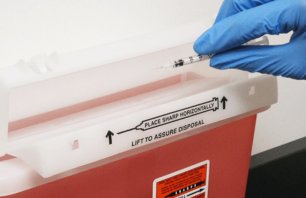March 08, 2023

World Kidney Day is celebrated on the second Thursday of March. According to the Centers for Disease Control and Prevention (CDC), an estimated 37 million U.S. adults have chronic kidney disease (CKD). On average, every 24 hours, 360 people start dialysis for kidney failure. Promoting a culture of sharps safety in dialysis centers is important to help prevent injury and infection in both patients and healthcare workers.
Below are four practices healthcare providers that work in dialysis centers can use to help ensure effective sharps safety.
Do Not Reuse Sharps
Practicing injection safety protects patients and healthcare workers. The Standard Precautions section of the CDC’s 2007 Guideline for Isolation Precautions provides recommendations on safe injection practices. An unsafe injection practice that can cause outbreaks includes using the same syringe to administer medication to more than one patient. To ensure safe injection practices, a good rule to remember is one needle, one syringe, only one time.
Wear Personal Protective Equipment
When used correctly, gloves can help prevent infection and needlestick injuries. Staff should understand when and how to use gloves, including safe removal and disposal methods.
Train Staff to Minimize Needlesticks
Dialysis center staff should receive regular training on how to properly handle sharps, including needles and syringes. This training is required per the Occupational Safety and Health Administration’s Bloodborne Pathogens (BBP) Standard for any employees who have occupational exposure to blood or other potentially infectious materials. The standard also dictates that a facility must have a thorough BBP exposure control plan, which outlines possible exposure risks, prevention strategies, and response procedures if a worker is exposed.
Dispose of Sharps Properly
In addition to implementing training and outlining clear protocols for needle use, contaminated sharps must be disposed of in sharps containers that are closable, puncture resistant, leakproof, and labeled/color-coded to indicate the potential hazard.
Stericycle offers several sharps disposal container and service options, including disposable containers or reusable containers that can help limit the number of single-use receptacles your facility sends to landfill. Stericycle also has a SafeDropTM sharps mail back solution, which provides biomedical waste containers in a variety of sizes and includes a cost-effective mail back method for returning the waste for treatment. The all-in-one sharps management kits offer everything needed to safely collect your sharps waste.
For more information on how Stericycle can help your organization foster a culture of sharps safety, go to Stericycle Sharps Management.
Stericycle Can Enhance Your Sharps Management and Waste Program
What is the Occupational Safety and Health Administration's (OSHA) Bloodborne Pathogens Standard, and how does it apply to dialysis centers?
The Bloodborne Pathogens Standard outlines rules for maintaining proper safety in workplaces where employees have exposure to blood and other potentially infectious materials.
What are bloodborne pathogens, and how do they pose a risk to healthcare workers in dialysis centers?
Bloodborne pathogens are infectious microorganisms in human blood that can cause disease in humans. The three most recognized bloodborne pathogens (BBPs) are Human Immunodeficiency Virus (HIV), Hepatitis B virus (HBV), and Hepatitis C virus (HCV); however, in healthcare and laboratory settings, the occupational transmission of more than 20 pathogens have been reported.
How can dialysis centers help protect healthcare workers from sharps injuries?
Dialysis centers can develop and implement a sharps injury prevention program. The program should be integrated into existing performance improvement, infection control, and safety programs.
How can dialysis centers assess and evaluate the effectiveness of their sharps injury prevention program?
To assess and evaluate the effectiveness of their sharps injury prevention program, dialysis centers should conduct a baseline assessment of their program and set priorities for the development of an action plan. There should be an ongoing process of review that evaluates the plan’s effectiveness and modification of the plan as needed.
What kind of training should healthcare workers in dialysis centers receive to help minimize needlestick injuries?
All healthcare employees with exposure to blood or other potentially infectious materials should undergo regular training on OSHA’s Bloodborne Pathogens Standard as well as organization-specific sharps use and disposal protocols.
What are the options for sharps disposal in dialysis centers?
Stericycle offers reusable sharps containers. Every reusable container from Stericycle can be reused up to 600 times. This can help reduce the amount of single-use plastic your facility sends to landfills.
How can healthcare workers protect themselves from needlestick injuries when administering injections to dialysis patients?
Healthcare workers can use an exposure control plan that includes engineering and work practice controls, personal protective clothing and equipment (PPE), regular employee training, medical surveillance, hepatitis B vaccinations, and other provisions required by OSHA's Bloodborne Pathogens Standard.
What are the consequences of not properly implementing sharps safety protocols in dialysis centers?
Sharps-related injuries risk the transmission of BBPs (such as HIV, HBV, and HCV), which can cause serious lifelong health issues and can even be fatal.
You may also like…
Receive Stericycle’s latest content, including news and regulations on how you can maintain business compliance.



